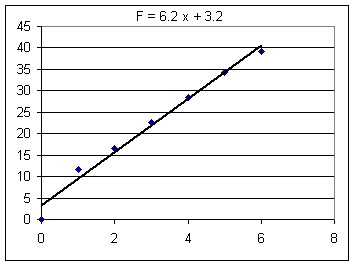
class 050914
Write down the 4 equations of uniformly accelerated motion. Time limit: 2 minutes.
Write down the definition of velocity and the definition of acceleration. Time limit: 2 minutes.
Find the slope and area beneath the following graph, and give the meaning and the units of the slope and the area
Solve the equation vf = v0 + a `dt for `dt. Show your steps.
If you know v0, a and `ds, which of the four equations of uniformly accelerated motion will allow you to solve for vf?
| 0 | 0 |
| 1 | 11.8 |
| 2 | 16.7 |
| 3 | 22.5 |
| 4 | 28.4 |
| 5 | 34.3 |
| 6 | 39.2 |

int(f(x),x,0,6)
F = 6.2 x + 3.2 indicates that the best-fit straight-line graph has slope 6.2 andb vertical intercept 3.2.
The meaning of the slope is rise / run = change in force / change in position, and units of the slope are N / ft.
The meaning of an area under the graph is average force * change in position, in units of N * ft. This is work, in N * ft.
How much work was done in stretching the cord out to an additional length of 6 ft?
I don't really have anything that I need help with right at this moment. I
think that everything is going ok for now, but if I have any questions I will
know how to send them to you.
<h3>Part of the reason for the assignment is to engage skills related to the
process of thinking of and phrasing a good question. Everyone needs to do
this.</h3>
I do not understand how to do rapid estimating. Please tell me how to do the
following questions. Estimate the order of magnitude (power of ten) of: a)2800
B)86.30 * 10(raised to 2) c) .0076 and D)15.0 * 10 (raised to 8).
<h3>I'll leave it to you to calculate the results for these numbers, but here
are some examples:
When rounding to the nearest 10:
Numbers from 1 to 5 round off to 1.
Numbers from 5 to 10 round off to 10.
The order-of-magnitude estimate is obtained by expressing the number in
scientific notation, and rounding the first factor to the nearest 10.
So, for example, rounding to the nearest 10:
3.5 rounds off to 1
8.2 rounds off to 10
4.789 rounds off to 1
6.025 rounds off to 10
We use this idea to round off each of the following:
75,000 = 7.5 * 10^4. Rounding the first factor 7.5 to the nearest 10 we get 10,
so our order-of-magnitude estimate becomes 10 * 10^4, which is 10^5.
1259 = 1.259 * 10^3. Rounding the first factor 1.259 to the nearest 10 we get 1,
so our order-of-magnitude estimate becomes 10 * 10^3, which is 10^4.
.0093 = 9.3 * 10^-4. Rounding the first factor 9.3 to the nearest 10 we get 10,
so our order-of-magnitude estimate becomes 10 * 10^-4, which is 10^-3.
How do we find the area inside of a graph?
<h3>You find the area under a trapezoidal region by multiplying average
'altitude' by width. See also notes from 9/9/05.</h3>